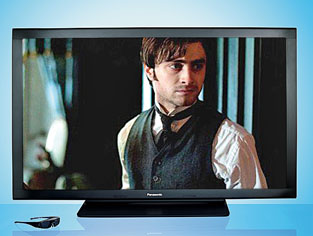What Hi-Fi? Verdict
A luxury option to be sure, but also the finest plasma display we’ve ever tested
Pros
- +
Sensational picture quality
- +
exemplary build
- +
considerable scope for adjustment
Cons
- -
No speakers, streaming or integrated TV tuner
- -
very expensive
Why you can trust What Hi-Fi?
In our gadget-obsessed culture it’s become the norm to judge a new product not merely on how well it performs, but also on how much it can do.
Convergence is the new religion, features and flexibility its twin mantras – so much so that that the sparse spec sheet that accompanies Panasonic’s new TH-65VX300 3D plasma display seems not so much improbable as heretical.
After all, the same company’s TH-P65VT30 television sports Freesat and Freeview HD tuners, loudspeakers, an extensive array of video, audio and data inputs, plus a huge portfolio of network-based streaming services.
The TH-65VX300 has almost nothing: no online access, no tuners, not even any speakers (although it does include 10W per channel speaker outputs). It is also no larger than its VT30-series sibling, at least not in terms of viewable screen area – and yet it costs twice as much.
Pro-series monitor
So, what gives? Well, while the VT30 is a Viera-series television aimed at the high street, the VX300 is a pro-series monitor aimed at custom installers, home cinema fans and production studios.
The nature of its market affords the VX300 scope to be a more focused offering: it’s not a stripped-down version of a regular TV, but a bespoke, precision-engineered and performance-orientated display designed to deliver maximum picture quality – and nothing else.
Key to the VX300’s ability is its new 30-bit image engine (older Panasonic plasmas used 20-bit designs).
That improvement in processing power is accompanied by a new ultra-high-speed panel drive system that effectively doubles the number of ‘gradation’ steps (the transition from one tint or shade to another) the screen can display.
The VT30 musters 6,144, but the VX300 can generate 12,288.
What does that actually mean in terms of picture quality? In a word: clarity. The VT30’s picture was hardly poor, but the VX300’s is palpably better.
Movement is exemplary, with none of the judder of entry-level sets and none of the forced, unconvincing smoothness of their supposedly superior siblings.
Banishes colour banding
The Panasonic also banishes the problem of colour ‘banding’, where background shots such as blue skies, and especially sunsets or sunrises, are rendered as distinct horizontal bands of colour; as a result, and especially with 1080p from a good Blu-ray, its pictures appear uncannily sharp, and also show no apparent trace of instability or noise.
Shadows are subtler and dark areas of the screen more revealing than any on any rival: the VX300 uncovers detail rivals either hint at or just overlook.
Switch to a standard-definition source and the VX300’s upscaling and image processing are excellent, too. It doesn’t punish DVD or broadcast TV sources, while its scale and its fast response time make it a fine choice for gaming use.
But the VX300 reserves its biggest thrills for 3D. It doesn’t come with glasses (which, we have to say, seems mean) but the active-shutter Panasonic samples supplied to us for our review are comfortable enough, and the set’s 3D performance is simply amazing.
A truly immersive picture
It suffers from even less crosstalk than a Viera-series model (and those are still rather good in this regard), and together with all its other enhancements, the result is a picture that does full justice to the best current 3D Blu-ray transfers.
Of course, the fact you’re watching a 65in picture helps, too: 3D just seems to work better the more it fills your immediate field of view, and that’s something the TH-65VX300 does rather well.
Whether that’s enough to justify the price tag is another matter. Granted, it’s impeccably constructed and, as befits a professional monitor, it’s bristling with picture-adjustment and calibration options.
It’s also as close to being ‘spot on’ out of the box as any display we’ve tested. On the other hand, it’s very basic in other regards, and far from cheap. Still, if you want the best, this is it.
See all our TV Best Buys
Follow whathifi on Twitter
Join whathifi on Facebook
What Hi-Fi?, founded in 1976, is the world's leading independent guide to buying and owning hi-fi and home entertainment products. Our comprehensive tests help you buy the very best for your money, with our advice sections giving you step-by-step information on how to get even more from your music and movies. Everything is tested by our dedicated team of in-house reviewers in our custom-built test rooms in London, Reading and Bath. Our coveted five-star rating and Awards are recognised all over the world as the ultimate seal of approval, so you can buy with absolute confidence.


